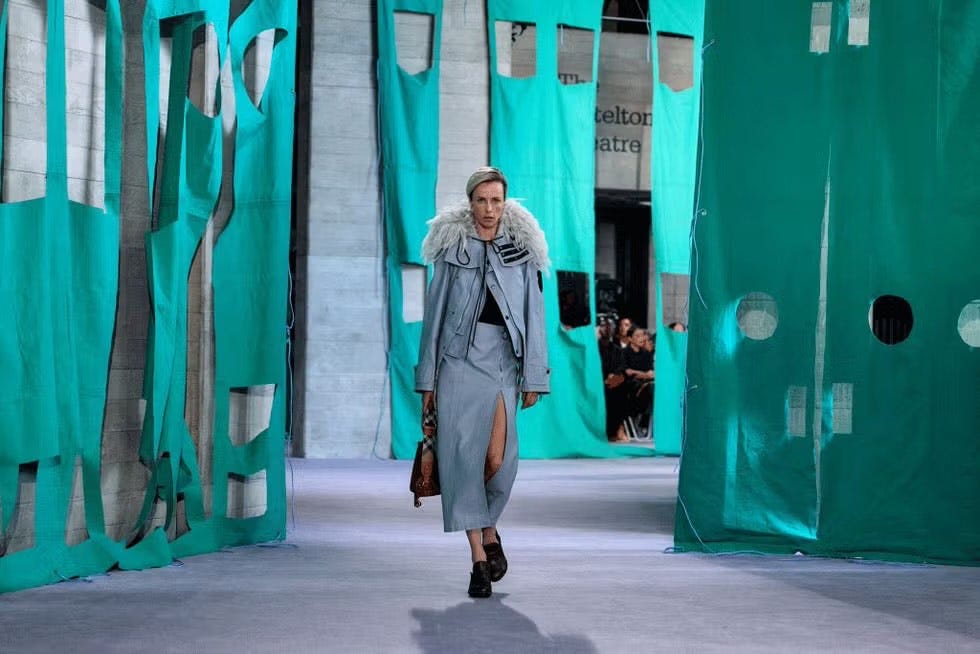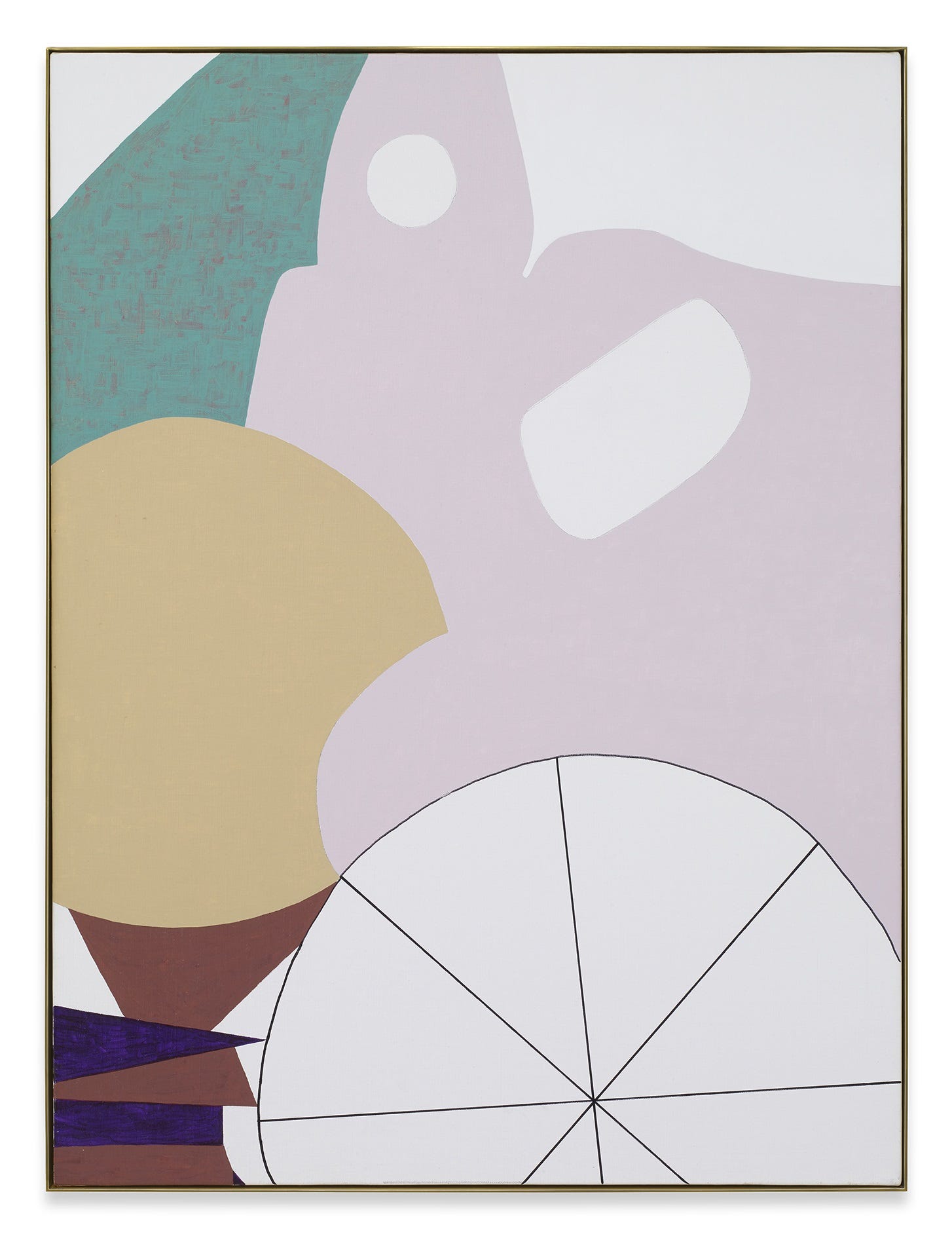Burberry Reconstructs its Heritage for Summer 2025
Daniel Lee presents a light, fresh and down-to-earth Ready-To-Wear collection

Burberry has changed grass for concrete in this Monday’s runway. Britain’s biggest luxury fashion brand, which usually sets its shows in London park settings, took over the foyer of the National Theatre. The venue’s transformation by 1900’s Young British Artist Gary Hume’s set of teal-coloured cut-out pieces of cloth was a statement: Burberry is taking a new direction.
Former Bottega Veneta creative director Daniel Lee took over the role of chief creative director in September 2022. The choice of the Brutalist building as the setting revealed what he said was “a real proposition”. This architectonic style of Modernist principles stemming from the need to rebuild destruction in World War II’s aftermath, had the main purpose of removing unnecessary ornamentation and was defined by raw materials.
The functional aesthetic of the venue was complemented by Hume’s installation based on his 1990s piece ‘Bays’. The blend of both – the building’s practical nature and the refreshing green canvas – captured, even before the show started, Lee’s collection purpose: pragmatism with a touch of joy and “a warm sense of familiarity”.

A blend of high-profile personalities – from actor Barry Keoghan to Olympian Katarina John-Thompson – sat on the front row, witnessing Burberry’s first show under new CEO Joshua Schulman.
Schulman took Burberry’s helm following its value drop of 42% in the last year. Facing the threat of becoming another victim of the haute couture slowdown, Schulman aims to make the brand more accessible, broadening the company’s appeal. His previous roles at Michael Kors and Coach indicate that Burberry will shift its focus towards accessible luxury, defining the brand as “equal parts of heritage and innovation.”
The collection showcased in the National Theatre undoubtedly followed Schulman’s vision: the predominantly neutral colour palette of beige, grey, and pastel blue defines the collection’s versatility. “You can wear them day to night. That’s what Burberry is for,” said Lee of his collection to 10 Magazine. Bright orange and lilac also stood out on the catwalk, breaking with the toned-down hues.

Simultaneously, Lee’s colour choices reflected Humbe’s paintings’ aesthetic: The light shades of blue, lilac and beige in clothes are consistently seen in the artist’s productions. The “Burberry lilac” handmade carpet on which the models were walking made the show become a living canvas of his work.
Light blue was the star colour of the show, balancing freshness and neutrality. Soft blue hues, seen in Chanel’s suits and Stella McCartney’s shirts in recent shows, have also taken over Burberry clothing. The colour was showcased in various forms: from midi dresses to high-heeled sandals. This will be one of the main colours of the season: Pantone, colour’s global authority, has named “Airy Blue” one of Spring Summer’s top 10.
.
"Burberry icons evolve," said Daniel Lee in his show notes. The reconstruction of the brand has also brought with a deconstruction of the trench, the brand’s signature piece. Lee granted outerwear staples some of the trench’s iconic elements: straps, epaulettes and flaps. Slouchy parkas, waist-length capes, and multi-pocketed field jackets became, in a way, the trenche’s successors.
“Trench elements are deconstructed and realised in fabrics that feel light: silk poplin and linen," explained Lee. Nevertheless, the classic piece has also been presented in its original form incorporating the collection’s signature colours: the trench coat appeared in light beige, gray and cream.

This creation diverges with the Spring Summer 2024 collection Lee brought last year to the catwalk. Predominance of print, delicate floral dresses, unbuttoned silk blouses – and even a topless model – contrast with this year’s focus on layering and practicality. “(Burberry’s) original purpose to protect people from the weather is more relevant than ever,” commented CEO Schulman when joining the company. Whether to achieve an increase in sales or reshape the brand’s identity, wearability is undeniably a key axis of the collection.
However, Lee has proved that Burberry’s reconstruction is not a resignation letter to glamour, but a demonstration that there is still room for classic nostalgia within modernity. Silk feather trims and collars on waist-cut coats were layered over shiny ruffles and sequin dresses. Slouchy cargo trousers and boxy square-pocket jackets were styled with knot silk scarfs. Lee’s collection illustrated a love story between adventure and luxury

In case you doubted it, Burbery’s signature check is not going anywhere. The re-interpretation of the house codes has led to a predominantly subtle appearance of the tartan patterns in clothing: these have been in subdued shades, reinforcing Lee’s bet on “quiet luxury”. Check has occasionally appeared in its original version, especially standing out in accessories: silky scarves, bags, and belts carried the brand’s unmistakable heritage.
"We want the runway shows to feel like a dream, but we also want the clothing to feel like a real proposition, too," told Lee to the press backstage. And it is undeniable that he achieved his goal. “It certainly felt more wearable than ever,” wrote ELLE Fashion Features Director Véronique Hyland.



